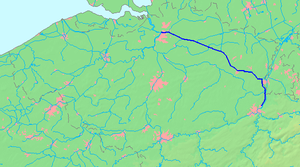Albert Canal
| Albert Canal | |
|---|---|

|
|
| Specifications | |
| Length | 80.5 miles (129.6 km) |
| Locks | 6 |
| History | |
| Construction began | 1930 |
| Date of first use | 1939 |
| Geography | |
| Start point | Liège |
| End point | Antwerp |
The Albert Canal (Dutch: Albertkanaal, French: Canal Albert) is a canal located in northeastern Belgium, which was named for King Albert I of Belgium. The Albert Canal connects Antwerp with Liège, and also the Meuse River with the Scheldt River. It also connects with the Canal Dessel-Turnhout-Schoten, and its total length is 129.5 kilometres (80.5 mi).
The Albert Canal has a standard depth of 3.4 metres (11 ft) and an overhead clearance of 6.7 metres (22 ft). To allow four-stacked container traffic, bridges over the canal are currently being heightened to allow for a 9.1 metres (30 ft) overhead.
The largest vessels that can use this canal are barges of just 10,000 tons - much smaller than the ones on the Rhine or the Danube or the ones in the waterways of the United States and Canada.
Between Antwerp and Liège, there is a difference in elevation of 56 metres (184 ft), and six sets of canal locks were needed to overcome this difference. Five canal locks each have a lift of 10 metres (33 ft), and these are located in Genk, Diepenbeek, Hasselt, Kwaadmechelen, and Olen, Belgium. The sixth lock at Wijnegem has a lift of 5.45 metres (17.9 ft).
...
Wikipedia
